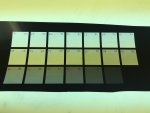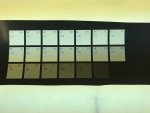I'm trying to gain more information as to what is causing this problem. I ran several jobs through our AccuSet 1000 image setter. The first job that was imaged reads correctly, but the jobs behind it all read 25-30 percent lower on the density block. I have changed the fixer and developer, and the temps are correct. The reason I am convinced this is an image setter issue is because I noticed a hard line through one of the films that measured properly, almost as if the density dipped back down to 70 percent. Also, I ran a motor cleaning in hopes that it might work, but no such luck. Has anyone experienced this issue first-hand? I'm open to any and all feedback. Thanks.
You are using an out of date browser. It may not display this or other websites correctly.
You should upgrade or use an alternative browser.
You should upgrade or use an alternative browser.
AGFA AccuSet 1000 density issue
- Thread starter tsinger
- Start date
SteveSuffRIT
Well-known member
So I understand your question better, when you say "reads 25-30 percent lower on the density block" you mean absolute density units and not some percentage (%). Instead of getting a Dmax = 4.0, you're only getting 3.7. (4.0 - .3 = 3.7).
Steve Suffoletto
Steve Suffoletto
Correct, Steve. This CTF stuff is still very new to me, so please bear with me.
After the film is developed, I use a density meter and check to make sure the film was exposed properly. The color blocks and solid areas are generally where I measure absolute density, and it appears to be 25 percent lower in that area. I hope that made sense!
After the film is developed, I use a density meter and check to make sure the film was exposed properly. The color blocks and solid areas are generally where I measure absolute density, and it appears to be 25 percent lower in that area. I hope that made sense!
You should inspect closely and compare the Black Blocks visually on a light table and on top of each other.
Did the solid Black lose density and actually turn Grey?
Seems you are using a Transmission Densitometer, measuring Dot Percentage.
What make and model is it?
Does it have an integrated light table OR are you using a hand-held instrument and measure on a light table?
Did the solid Black lose density and actually turn Grey?
Seems you are using a Transmission Densitometer, measuring Dot Percentage.
What make and model is it?
Does it have an integrated light table OR are you using a hand-held instrument and measure on a light table?
Slammer
Well-known member
Am I correct in understanding that some of the measured "blocks" are correct and others no so much?
I the Accuset there is an all-angle prism that reflects the laser to the film, this can pick up dust and other debris rather easy, then the spinner mirror can also be dirty or it is going blind which will also bring this effect.
I the Accuset there is an all-angle prism that reflects the laser to the film, this can pick up dust and other debris rather easy, then the spinner mirror can also be dirty or it is going blind which will also bring this effect.
Correct, Repro_Pro. It's a densitometer that measures dot percentage on each negative. It's an X-Rite 361T.
Correct, Slammer. I imaged seven jobs in total (six negs for each job), and the first job processed fine. The following six were mostly bad, with the exception of about seven negs that randomly read proper exposure. The dark areas are reading zero, which leads me to believe that my chemicals are fine.
Correct, Slammer. I imaged seven jobs in total (six negs for each job), and the first job processed fine. The following six were mostly bad, with the exception of about seven negs that randomly read proper exposure. The dark areas are reading zero, which leads me to believe that my chemicals are fine.
VladCanada
Well-known member
First of all, check the density on daylight exposed piece of film to find a culprit: Accuset or film processor.
VladCanada
Well-known member
I need to know actual optical density (D mode) not a percentage (DOT % mode)
VladCanada
Well-known member
And what a density on 100% square exposed by Accuset?
VladCanada
Well-known member
Your chemistry is perfect BTW.
VladCanada
Well-known member
Did you "zeroing" densitometer before reading?
Similar threads
- Replies
- 7
- Views
- 1580
InSoft Automation
|
InSoft Automation Unveils Imp Version 14
Revolutionizing Layout Planning and Automation InSoft Automation announces the launch of Imp Version 14, the latest iteration of its industry-leading cost-based layout planning software. Packed with cutting-edge features, this release redefines efficiency, automation, and workflow optimization for printing and finishing processes. Learn more……. |













